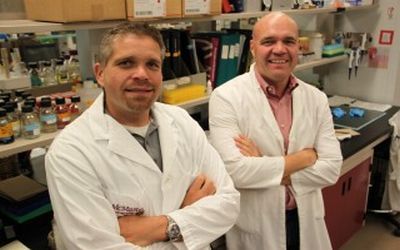Resistance to Antibiotics is Ancient
Scientists were surprised at how fast bacteria developed resistance to the miracle antibiotic drugs when they were developed less than a century ago. Now scientists at McMaster University have found that resistance has been around for at least 30,000 years.


McMaster evolutionary geneticist Hendrik Poinar, left, and Gerry Wright, scientific director of the Institute for Infectious Disease Research, are pictured in Wright's lab.
Scientists were surprised at how fast bacteria developed resistance to the miracle antibiotic drugs when they were developed less than a century ago. Now scientists at McMaster University have found that resistance has been around for at least 30,000 years.
Research findings published today in the science journal Nature show antibiotic resistance is a natural phenomenon that predates the modern clinical antibiotic use. Principal investigators for the study are Gerry Wright, scientific director of the Michael G. DeGroote Institute for Infectious Disease Research and Hendrik Poinar, McMaster evolutionary geneticist.
"Antibiotic resistance is seen as a current problem and the fact that antibiotics are becoming less effective because of resistance spreading in hospitals is a known fact," says Wright. "The big question is where does all of this resistance come from?"
After years of studying bacterial DNA extracted from soil frozen in 30,000-year-old permafrost from the Yukon Territories, the researchers were able to develop methods to isolate DNA within McMasters Ancient DNA Centre. Using state-of-the-art molecular biological techniques, methods were developed to tease out small stretches of ancient DNA.
Researchers discovered antibiotic resistant genes existed beside genes that encoded DNA for ancient life, such as mammoths, horse and bison as well as plants only found in that locality during the last interglacial period in the Pleistocene era, at least 30,000 years ago. They focused on a specific area of antibiotic resistance to the drug vancomycin, a significant clinical problem that emerged in 1980s and continues to be associated with outbreaks of hospital-acquired infections worldwide.
This is only the second time an ancient protein has been revived in a laboratory setting.
Wright said the breakthrough will have important impact on the understanding of antibiotic resistance: "Antibiotics are part of the natural ecology of the planet so when we think that we have developed some drug that wont be susceptible to resistance or some new thing to use in medicine, we are completely kidding ourselves. These things are part of our natural world and therefore we need to be incredibly careful in how we use them. Microorganisms have figured out a way of how to get around them well before we even figured out how to use them."
Poinar says this discovery has opened doors for ancient antibiotic resistance research. "We can go back a million years in the permafrost, which is our next goal."
Funding for this project came from the Canada Research Chairs program, the Canadian Institutes of Health Research and the Natural Sciences and Engineering Research Council.
Redefining Competency: A Comprehensive Framework for Infection Preventionists
December 19th 2024Explore APIC’s groundbreaking framework for defining and documenting infection preventionist competency. Christine Zirges, DNP, ACNS-BC, CIC, FAPIC, shares insights on advancing professional growth, improving patient safety, and navigating regulatory challenges.
Addressing Post-COVID Challenges: The Urgent Need for Enhanced Hospital Reporting Metrics
December 18th 2024Explore why CMS must expand COVID-19, influenza, and RSV reporting to include hospital-onset infections, health care worker cases, and ER trends, driving proactive prevention and patient safety.
Announcing the 2024 Infection Control Today Educator of the Year: Shahbaz Salehi, MD, MPH, MSHIA
December 17th 2024Shahbaz Salehi, MD, MPH, MSHIA, is the Infection Control Today 2024 Educator of the Year. He is celebrated for his leadership, mentorship, and transformative contributions to infection prevention education and patient safety.
Pula General Hospital Celebrates Clean Hospitals
December 16th 2024Learn how Pula General Hospital in Croatia championed infection prevention and environmental hygiene and celebrated Clean Hospitals Day to honor cleaning staff and promote advanced practices for exceptional patient care and safety.
Understanding NHSN's 2022 Rebaseline Data: Key Updates and Implications for HAI Reporting
December 13th 2024Discover how the NHSN 2022 Rebaseline initiative updates health care-associated infection metrics to align with modern health care trends, enabling improved infection prevention strategies and patient safety outcomes.